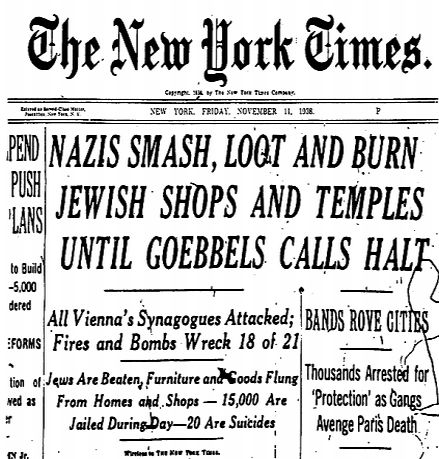
“The Night of Broken Glass”
This day in 1938 saw the organized destruction of Jewish businesses and homes in Munich, as well as the beating and murder of Jewish men, women, and children.
It was an exercise in terror that would be called “Kristallnacht,” or “the Night of Broken Glass,” because of the cost of broken glass in looted Jewish shops—$5 million marks ($1,250,000).
On November 7, in Paris, a 17-year-old German Jewish refugee, Herschel Grynszpan, shot and killed the third secretary of the German embassy, Ernst vom Rath. Grynszpan had intended to avenge the deportation of his father to Poland and the ongoing persecution of Jews in Germany by killing the German ambassador. Instead, the secretary was sent out to see what the angry young man wanted and was killed. The irony is that Rath was not an anti-Semite; in fact, he was an anti-Nazi.
As revenge for this shooting, Joseph Goebbels, Nazi minister of propaganda, and Reinhard Heydrich, second in command of the SS after Heinrich Himmler, ordered “spontaneous demonstrations” of protest against the Jewish citizens of Munich. The order, in the form of a teletyped message to all SS headquarters and state police stations, laid out the blueprint for the destruction of Jewish homes and businesses. The local police were not to interfere with the rioting storm troopers, and as many Jews as possible were to be arrested with an eye toward deporting them to concentration camps.
In Heydrich’s report to Hermann Goering after Kristallnacht, the damage was assessed: “…815 shops destroyed, 171 dwelling houses set on fire or destroyed… 119 synagogues were set on fire, and another 76 completely destroyed… 20,000 Jews were arrested, 36 deaths were reported and those seriously injured were also numbered at 36…”
The extent of the destruction was actually greater than reported. Later estimates were that as many as 7,500 Jewish shops were looted, and there were several incidents of rape. This, in the twisted ideology of Nazism, was worse than murder, because the racial laws forbade intercourse between Jews and gentiles. The rapists were expelled from the Nazi Party and handed over to the police for prosecution. And those who killed Jews? They “cannot be punished,” according to authorities, because they were merely following orders.
To add insult to massive injury, those Jews who survived the monstrous pogrom were forced to pay for the damage inflicted upon them. Insurance firms teetered on the verge of bankruptcy because of the claims. Hermann Goering came up with a solution: Insurance money due the victims was to be confiscated by the state, and part of the money would revert back to the insurance companies to keep them afloat.
The reaction around the world was one of revulsion at the barbarism into which Germany was sinking. As far as Hitler was concerned, this only proved the extent of the “Jewish world conspiracy.”
More events of November 9 are available at History.com
A more detailed article is available at the Holocaust Memorial Museum